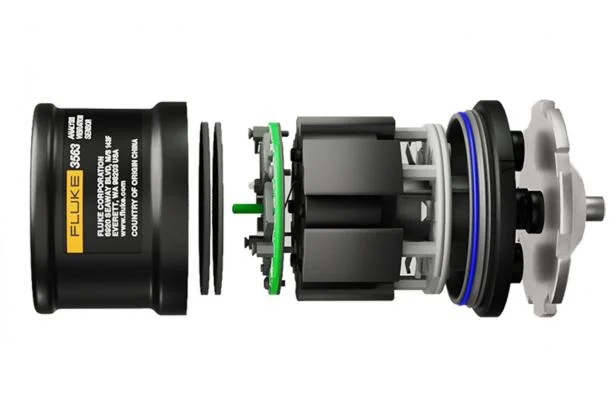
What is an Accelerometer?
Accelerometers are transducers — devices that convert energy from one form to another. And when exposed to dynamic forces, they convert that mechanical energy into electrical energy. The resulting electrical signals are directly proportional to the forces measured. Accelerometers can be used to measure a variety of forces, such as vibration, shock, or acceleration of motion. Today, more and more maintenance teams are using accelerometer vibration sensors for condition monitoring on their assets.
How Accelerometer Vibration Sensors Work
All machinery vibrates, but changes in vibration can be an early indicator of potential problems. Excessive vibration can cause premature wear in components and shorten asset life. Vibration monitoring makes it possible to detect and diagnose problems before they become severe.
Rotating machinery, including fans, motors, and pumps, is prone to four common types of mechanical faults: imbalance, looseness, misalignment, and bearing wear. Vibration monitoring can detect anomalies related to each of these types of faults.
Accelerometers are placed directly in or on vibrating equipment. (For some applications, a non-contact device such as an eddy-current sensor — which does not require direct contact with the source of the vibration — is recommended.) Data from an accelerometer can be used for vibration analysis to identify changes in the vibration pattern of the equipment it is mounted on.
The mounting technique used to attach an accelerometer to a surface can impact the measurable frequency of the accelerometer. Possible mounting techniques include magnets, adhesives, and studs.
Different Types of Accelerometer Vibration Sensors
There are numerous types of accelerometer vibration sensors available, each with different features, strengths, and applications.
Piezoelectric Sensors
When certain types of quartz or crystal are compressed, they produce an electrical charge. This is called the piezoelectric effect. Piezoelectric accelerometers (often shortened to “piezo” or piezo vibration sensors) use this phenomenon to capture changes in physical parameters like temperature or vibration. The changes they capture are converted into measurable electrical signals proportional to the mechanical stress applied to the quartz or crystal. Piezoelectric accelerometers have a wide frequency range and can withstand harsh environments, including high temperatures.
MEMS Accelerometers
MEMS stands for micro-electrical-mechanical systems. MEMS accelerometers are small, inexpensive, and use little power, which has made them enormously popular. You can find MEMS accelerometers in a dizzying array of modern electronics and industrial applications. The tradeoff is that their data quality is lower than some of the other types of accelerometers available, like piezo sensors. However, in the maintenance world, MEMS vibration sensors can be put to work at great scale for condition monitoring, allowing teams to keep track of hundreds of assets at once at a much more affordable price.
Single-Axis Accelerometers vs. Triaxial Accelerometers
Single-axis accelerometers are the most common type. They measure vibration along a single axis while detecting the level of mechanical vibration.
Triaxial accelerometer vibration sensors can simultaneously measure vibration along three perpendicular axes while detecting all of the vibration components affecting an object. Unlike single-axis accelerometers, triaxial accelerometers can determine the type of vibration present — not just the level.
How Accelerometer Vibration Sensors are Used
There are far too many accelerometer vibration sensor applications to list them all in one article. Any industry that needs to maintain and diagnose rotating equipment, or to ensure the stability of structures, can use accelerometers. Accelerometers can also be used to monitor the stresses on sensitive or specialty equipment, such as electron microscopes, during transit.
When used for condition monitoring in industrial applications, like the vibration sensors made by Fluke Reliability, accelerometers are typically installed on equipment including fans, compressors, pumps, rollers, turbines, and more.
The Benefits of Vibration Monitoring
Vibration monitoring helps maintenance and reliability teams identify potential machine faults and plan their actions accordingly. Making repairs either too early or too late can be costly — in time, money, and parts. But condition-based maintenance uses machine condition, rather than a calendar, to determine what needs attention and when.
Condition-based maintenance eliminates unnecessary maintenance actions and reduces unplanned downtime, while also improving asset uptime and extending asset life. Vibration monitoring, which can detect faults 12 to 18 months ahead of asset failure, can be an integral part of a successful condition-based maintenance program.
